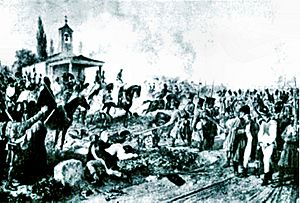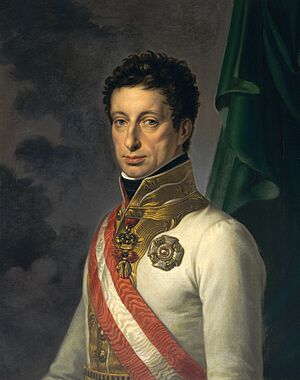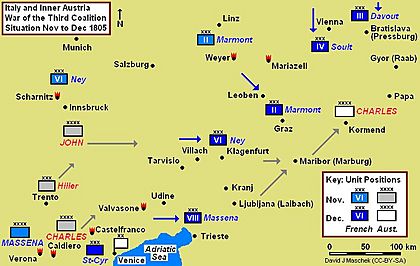Battle of Caldiero (1805) facts for kids
Quick facts for kids Battle of Caldiero |
|||||||
|---|---|---|---|---|---|---|---|
| Part of the War of the Third Coalition | |||||||
 Archduke Charles and staff at the Battle of Caldiero |
|||||||
|
|||||||
| Belligerents | |||||||
| Commanders and leaders | |||||||
| Strength | |||||||
| 33,000–49,000 23,600–33,000 engaged |
49,200 | ||||||
| Casualties and losses | |||||||
| 3,729 total: 3,204 killed or wounded 525 captured |
9,221 total: 503 killed 2,209 wounded 1,509 captured a further 5,000 captured at Cara Albertini |
||||||
The Battle of Caldiero was a big fight that happened on October 30, 1805. It was part of the Napoleonic Wars, a series of major conflicts in Europe. In this battle, the French army, led by Marshal André Masséna, faced off against the Austrian army, commanded by Archduke Charles. The battle took place near a town called Caldiero in what is now Italy.
The French used about 33,000 soldiers, while the Austrians had a larger force of 49,000 men. Even though the Austrians had more soldiers, the French managed to win this important battle.
Leading Up to the Battle
In mid-October 1805, Marshal André Masséna, a very experienced French general, was waiting for news from another big battle happening in Bavaria. He had fought the Austrians before in Italy.
On October 18, Masséna's troops won a key position by crossing the Adige River in the Battle of Verona. This was a tough fight. The French lost some soldiers, but the Austrians had even more casualties. Archduke Charles was so unhappy with his general's performance that he replaced him.
News finally reached Masséna on October 28 that Emperor Napoleon I had defeated the main Austrian army in Bavaria. This was a huge victory for the French. Because of this, Masséna immediately ordered his army to attack the Austrians in northern Italy. He planned to cross the Adige River and move into Austrian territory.
There was also fighting on October 29, which some historians consider part of the Battle of Caldiero. On that day, French troops pushed the Austrians back from some key areas. The French had about 527 soldiers killed or wounded, and 157 captured. The Austrians had even higher losses, with 1,926 killed or wounded and 1,114 taken prisoner.
Archduke Charles knew that the defeat in Bavaria was bad news for Austria. He wanted to move his army towards Vienna to join up with other Austrian and Russian forces. But he didn't want Masséna's army chasing him. So, he decided to turn around and fight the French. He hoped that by winning this battle, he could safely march his army deeper into Austria.
Battle Plans
Archduke Charles had already prepared for a French attack. He set up his defenses in the important village of Caldiero. This village was on the main road from Verona. He placed many cannons and mortars, a total of 58 cannons and 24 mortars, to defend the area.
The Austrian army was split into three main groups:
- On the right, General Joseph Anton von Simbschen held the high ground and a valley.
- In the middle, General Count Heinrich von Bellegarde protected the main road and some hills.
- On the left, Prince Heinrich XV of Reuss-Plauen's forces stretched the Austrian line, with another group covering the river.
After looking at the Austrian positions, Masséna made his own plan:
- General Gardanne's troops would lead the attack on both sides of the main road.
- To the left, Molitor's division would try to capture the high ground.
- To the right, Duhesme's troops would attack Caldiero later in the day.
- Finally, Verdier's troops would cross the Adige River to try and attack the Austrian left flank from behind.
The Battle Begins
Masséna wanted to wait for Verdier's troops to attack the Austrian flank before launching a full frontal assault. However, Archduke Charles attacked first, hitting both sides of the French army.
On one side, Simbschen's cavalry attacked Molitor's French troops. Molitor's soldiers fought back and pushed Simbschen's forces up the hills. The French tried to capture the high ground, but the Austrians received reinforcements and managed to push them back. The fighting continued all day, but the Austrians held onto the hills.
In the center, General Gardanne's French troops slowly fought their way towards Caldiero against a strong Austrian defense led by Bellegarde. Gardanne's first attack failed, and he had to fall back. But with more soldiers joining him, Gardanne attacked again and managed to capture the important village of Caldiero.
The Austrians launched a fierce counterattack and took the village back. But Gardanne received even more reinforcements and recaptured Caldiero. The Austrians, now reinforced by Reuss-Plauen's troops, made another big effort to drive the French out. After intense hand-to-hand combat, the French, led by Gardanne, finally took control of the village and held it.
On the far right, Verdier's troops were trying to go around the Austrian army. But Verdier found out that some Austrian troops had already crossed the river. So, instead of attacking from behind, Verdier's forces ended up facing a large group of Austrians head-on. The Austrians soon forced the French back across the river.
As night fell, the fighting stopped. The Austrians began to pull back from most parts of the battlefield. Archduke Charles decided not to continue the battle the next day and started to retreat during the night.
Aftermath and Retreat
Both sides suffered many losses in the battle. The French lost about 3,700 soldiers, while the Austrians lost around 4,200. The French also lost a colonel, a high-ranking officer. Some French regiments fought so hard that they almost lost their battle flags, which were very important symbols.
After the battle, on October 30, the Austrians also lost another 5,000 soldiers and 70 officers who were forced to surrender at Cara Albertini. These soldiers were supposed to be released, but they were not.
Archduke Charles began his main retreat on November 1, leaving a smaller group of soldiers behind to slow down the French. This group fought well, but the French kept pushing them.
The Austrian generals, Bellegarde, Rosenberg, and Reuss, fell back to Vicenza. Another Austrian group withdrew to Padua. Archduke Charles hoped to cause problems for Masséna's army by sending more troops to Venice. However, another French division, led by Laurent de Gouvion Saint-Cyr, was already marching towards Venice. This allowed Saint-Cyr to block the port and prevent the Austrian soldiers there from bothering Masséna's supply lines.
Archduke Charles continued his retreat, fighting small battles along the way to slow down the French. He managed to cross the Isonzo River on November 13. Even though the French were chasing him, Masséna's main army was actually several days behind.
Meanwhile, other French armies were also on the move. Marshal Pierre Augereau's French troops forced another Austrian general, Jellacic, to surrender with his infantry on November 14. Another Austrian group, under Prince Louis Victor Rohan-Guéméné, was caught between two French divisions and forced to surrender on November 24.
Archduke Charles and his brother, Archduke John, finally joined their forces near Maribor on November 26. Together, they had a large army of 85,000 soldiers. However, Charles decided not to attack Vienna. Instead, he moved slowly into Hungary. By the time he reached Körmend on December 6, the very important Battle of Austerlitz had already happened. This battle was a huge victory for Napoleon and effectively ended the war.
Even after his big win, Emperor Napoleon still saw Archduke Charles's large army as a threat. So, he ordered Masséna to reorganize his army and move east. Other French armies also moved to surround Charles's forces. On December 26, the Treaty of Pressburg was signed, which officially ended the conflict.






